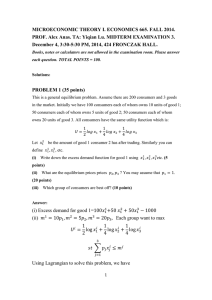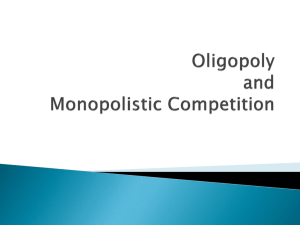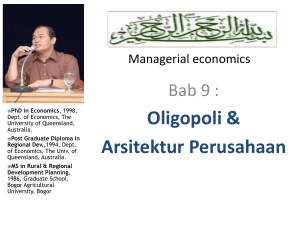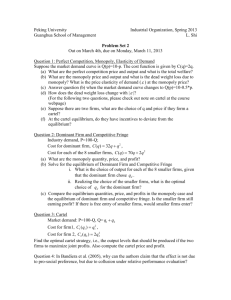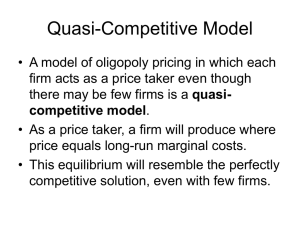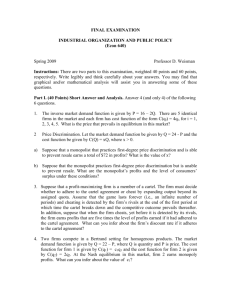Chapter 13, part B S '
advertisement
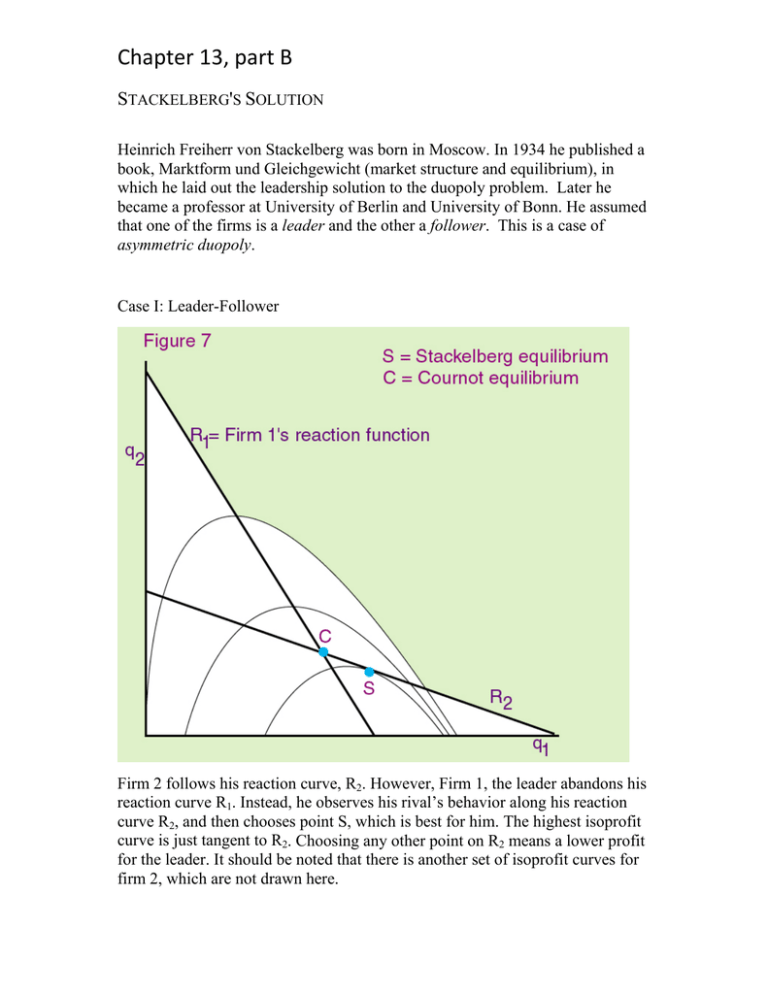
Chapter 13, part B STACKELBERG'S SOLUTION Heinrich Freiherr von Stackelberg was born in Moscow. In 1934 he published a book, Marktform und Gleichgewicht (market structure and equilibrium), in which he laid out the leadership solution to the duopoly problem. Later he became a professor at University of Berlin and University of Bonn. He assumed that one of the firms is a leader and the other a follower. This is a case of asymmetric duopoly. Case I: Leader-Follower Firm 2 follows his reaction curve, R2. However, Firm 1, the leader abandons his reaction curve R1. Instead, he observes his rival’s behavior along his reaction curve R2, and then chooses point S, which is best for him. The highest isoprofit curve is just tangent to R2. Choosing any other point on R2 means a lower profit for the leader. It should be noted that there is another set of isoprofit curves for firm 2, which are not drawn here. Case II: Follower-Follower (same as Cournot) Each firm assumes that the rival’s output is given and follows his own reaction curve. Case II: Leader-Leader m1 = Firm 1 is a monopolist (and Firm 2 produces nothing) m2 = Firm 2 is a monopolist (and Firm 1 produces nothing) S1 = Firm 1 is the leader (and Firm 2 is the follower) S2 = Firm 2 is the leader (and Firm 1 is the follower) D = Both firms try to be the leader, but neither is successful. Thus, a Stackelberg disequilibrium. 2 3 Which of the two theories, Cournot or Bertrand, is better? COURNOT OR BERTRAND? There is no single theory of oligopolistic behavior that applies to all markets. The key question is whether it takes longer for a firm to adjust its price or quantity. Are you saying in some markets Cournot model is better and Bertrand model is more suitable in other markets? Yes. In which markets is the Betrand model more suitable? In some markets production decisions are made annually, and once output decisions are made, it is difficult to change outputs. They can only modify prices in response to changes in market conditions. The quantity-setting Cournot model is appropriate when firms make fixed production plans; once output decisions are made, it is difficult to adjust their output levels. Cournot is a good model when there are long production lead times, or when firms need to invest in specialized capacity to produce the good. Can you give us a specific example? Think about building a supermarket. The owner must decide how large the store will be and how many checkout counters to have. After that, the level of output is largely fixed. Similar situations arise with gas stations and the number of pumps. Hotels. It takes a long time to build additional hotel rooms. Once the rooms are built, it makes no sense to reduce capacity. Then in which markets is the In manufacturing industries, such as 4 Bertrand model better? automobiles and airplanes, production occurs throughout the year, and prices are adjusted once a year for new models. In these markets, firms commit to prices rather than quantities, and hence the price-setting Bertrand model is more suitable. Once a mail-order catalogue is printed, it is too late to change prices. Bertrand model is also relevant for markets where firms compete by "bidding" for business. To get government contracts, firms submit fixed prices so government can choose from whom to purchase services. Is there any other area in which oligopolists can compete? The firms might use illegal means to destroy their rivals, and we do not have to elaborate all the illegal means here. The firms can also compete in quality. Quality Competition Both Cournot and Bertrand models assume that demand curves are fixed, and firms compete in terms of quantity or price. Modern oligopolies are much more complex. There is hardly any industry selling homogenous products. Even for bottled waters, different companies emphasize the quality of water they produce. Cell phone companies emphasize the new features or prices of their products each year. They also compete in after services. Consumers do not like to wait for a long time, and will quickly switch to other producers if the waiting time is too long. When Service Means Survival http://www.businessweek.com/magazine/content/09_09/b4121026559235.htm?chan=magazine+c hannel_in+depth Cutting just four reps at a call center of three dozen can send the number of customers put on hold for four minutes from zero to 80. 5 In some markets prices are stable and others unstable. Oil prices have been unstable in recent years. The kinked demand theory explains stable oligopoly prices, whereas the cartel theory explains why sometimes price war erupts in these markets. What is the kinked demand theory? Kinked Demand Theory In 1939, two papers, one by Hall and Hitch, and the other by Sweezy, argued that oligopolistic firms have "sticky" prices. Demand for an oligopolist depends not only on market conditions but also on the reaction of rival firms. This model is based on the pessimistic assumptions about the behavior of rival. What are the pessimistic assumptions? Each oligopolist believes that (i)A price cut will be matched, (ii) A price increase will not be matched. This implies stable or sticky prices. Pessimistic oligopolists may choose stable prices, but not all stable prices may be the result of kinked demand curves. Right! 1. An empirical study comparing 19 oligopolists with two monopolies showed that monopolies tend to have more rigid prices. 2. The kinked demand curve is not an adequate explanation of price rigidity under oligopoly. Price stability might be due to collusion. 3. Price rigidity may be due to a high cost of price adjustment. 6 For instance, in the auto industry prices are announced when new year models are delivered to the market. Prices do not change throughout the year. 7 What is a cartel? CARTEL A cartel is an organization of oligopolists that cooperate and act jointly as one firm. Cartels generally have a turbulent life. Why do they have a turbulent life? Because price agreements break down often. The life expectancy of a cartel depends on several factors. (i) the price elasticity of demand If demand is fairly elastic, a large reduction in output is necessary for a price increase. A large output reduction is difficult to achieve. (ii) the stability of demand A stable demand is more conducive to cartel survival. (iii) Entry barriers. Without barriers, a cartel will eventually break down. If there are no entry barriers, the industry will eventually become competitive. Right! How does a cartel choose price and output? Perfect Cartel What is the solution of a perfect cartel? It would be that of a multi-plant monopoly. If there were three members, and one member bought the other two, it would behave like a multi-plant monopolist. Will it set price so that MR = MC, and then allocate outputs among three Right! Let us begin with a perfect cartel. 8 members to minimize costs? Do cartel members accept such a solution? In general, no! Is that the only reason for disunity? No. Cartel members have different production costs. If there were two members, and a perfect cartel dictates 60% and 40%, smaller firm only asks more. There is a great incentive for small firms to cheat? Why? Incentive to Cheat: P exceeds MC In the above diagram, monopoly price exceeds marginal cost. The perfect cartel would maximize joint profit. Collectively, this solution 9 will maximize the total profits of the cartel. This does not, however, mean that firms will adhere to the cartel agreement. A cartel may contain the seed of its own destruction. Once the cartel sets the price, individual firms behave like price taking firms. Price exceeds marginal cost. Hence, each firm would gain by increasing output. Thus, each firm cheats. Firm 1’s output increases to a, and Firm 2’s output to b. The industry output expands to c, and price must fall. As price falls, the cartel falls apart. 10 Example: In the 1890s Chicago was the hub of the railroad system that linked east and west in the United States. There were five railroads that connected Chicago with the urban market of East Coast. Chicago became the meat packing capital of the country. As a result, railroads competed rigorously for shipping business. One time, however, after a long series of price war, the railroads decided to cooperate and to abide by the price fixing agreement. All five railroads did. No meat packers could get discount rates. Thus, meat packers got together and came up with an ingenious idea. They all agreed to give their businesses to one railroad and pay the monopoly price. The other railroads immediately found out that they were not getting any business. They assumed that the railroad with all the business was cheating when it was not. The manager, of course, protested that it was not cheating and that it never cut the price. But no one believed him. Other railroads began to contact the meat packers and began to offer discounts, and soon the cartel broke down. All cartels carry within them the seeds of self-destruction. 11 Dominant Firm Industry A dominant-firm industry is an industry that contains a large single firm with a fringe of small rivals, produces homogeneous or similar producers. It is characterized easy expansion of existing firms and also relatively easy entry. Currently, IBM in mainframe computers and much of the retailing sector provide examples of industries with dominant firms. IBM dominates the mainframe computer market and sets the level of price that its rival firms will accept. In most cities, a nationally known seller such as Sears, K mart, Safeway, etc. dominate the local market for goods and compete with locally owned stores. How to become a dominant firm. (i) initial attempt to monopolize. The firm is a monopolist at one time. Standard Oil, US Steel, Alcoa. Overtime other firms enter the market, and these firms become dominant firms. (ii) Merger: General Motors became a dominant firm through merger. (iii) successful innovation IBM, Xerox, Sears, Coca-cola. Dominant Firm Price Leadership. 12 Long Run: The share of the dominant firm declines. Example IBM is the giant that dominates the mainframe computer industry. It introduced its personal computer, the PC, in 1981. The IBM PC set a new industry standard by which all other personal computers were judged. Within three years IBM won half the personal computer market, and producers of IBM compatibles held another 25 percent. IBM's dominance of the PC market came under serious attack in 1983. Rival computer makers swarmed into the market, producing clones of IBM PC. By 1986 there were more than 200 firms operating in the industry. Many of these clone makers claimed that they were not only cheaper but also faster and more reliable than IBM PC. By 1986 the share of the clones rose to 62 percent. 13 IBM reacted to this decline by introducing PS/2, and threatened to sue other producers if they infringe upon the patents and copyrights of Micro Channel Architecture. Now there are significant rivals such as Compaq, Dell and Gateway. 14
